Related Research Articles
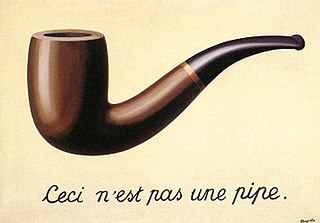
Surrealism is an art and cultural movement that developed in Europe in the aftermath of World War I in which artists aimed to allow the unconscious mind to express itself, often resulting in the depiction of illogical or dreamlike scenes and ideas. Its intention was, according to leader André Breton, to "resolve the previously contradictory conditions of dream and reality into an absolute reality, a super-reality", or surreality. It produced works of painting, writing, theatre, filmmaking, photography, and other media.

Elizabeth "Lee" Miller, Lady Penrose, was an American photographer and photojournalist. She was a fashion model in New York City in the 1920s before going to Paris, where she became a fashion and fine art photographer. During the Second World War, she was a war correspondent for Vogue, covering events such as the London Blitz, the liberation of Paris, and the concentration camps at Buchenwald and Dachau.
The British Surrealist Group was involved in the organisation of the International Surrealist Exhibition in London in 1936.

Frank Humphrey Sinkler Jennings was an English documentary filmmaker and one of the founders of the Mass Observation organisation. Jennings was described by film critic and director Lindsay Anderson in 1954 as "the only real poet that British cinema has yet produced".

Wolfgang Robert Paalen was an Austrian-Mexican painter, sculptor, and art philosopher. A member of the Abstraction-Création group from 1934 to 1935, he joined the influential Surrealist movement in 1935 and was one of its prominent exponents until 1942. Whilst in exile in Mexico, he founded his own counter-surrealist art-magazine DYN, in which he summarized his critical attitude towards radical subjectivism and Freudo-Marxism in Surrealism with his philosophy of contingency. He rejoined the group between 1951 and 1954, during his sojourn in Paris.
George Reavey was a Russian-born Irish surrealist poet, publisher, translator and art collector. He was also Samuel Beckett's first literary agent. In addition to his own poetry, Reavey's translations and critical prose helped introduce 20th century Russian poetry to an English-speaking audience. He was also the first publisher to bring out a collection of English translations of the French surrealist poet Paul Éluard.
Ithell Colquhoun was a British painter, occultist, poet and author. Stylistically her artwork was affiliated with surrealism. In the late 1930s, Colquhoun was part of the British Surrealist Group before being expelled because she refused to renounce her association with occult groups.
Paul Nougé was a Belgian poet, founder and theoretician of surrealism in Belgium, sometimes known as the "Belgian Breton".

Sir Roland Algernon Penrose was an English artist, historian and poet. He was a major promoter and collector of modern art and an associate of the surrealists in the United Kingdom. During the Second World War he put his artistic skills to practical use as a teacher of camouflage.
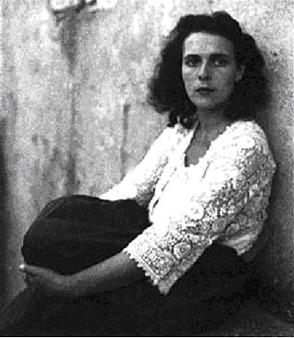
Mary Leonora Carrington was a British-born surrealist painter and novelist. She lived most of her adult life in Mexico City and was one of the last surviving participants in the surrealist movement of the 1930s. Carrington was also a founding member of the women's liberation movement in Mexico during the 1970s.
Édouard Léon Théodore Mesens was a Belgian artist and writer associated with the Belgian Surrealist movement.
Emma Frith Bridgwater, known as Emmy Bridgwater, was an English artist and poet associated with the Surrealist movement.
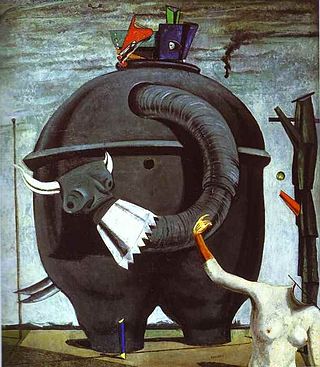
The Elephant Celebes is a 1921 painting by the German Dadaist and surrealist Max Ernst. It is among the most famous of Ernst's early surrealist works and "undoubtedly the first masterpiece of Surrealist painting in the de Chirico tradition." It combines the vivid dreamlike atmosphere of Surrealism with the collage aspects of Dada.
The Birmingham Surrealists were an informal grouping of artists and intellectuals associated with the Surrealist movement in art, based in Birmingham, England from the 1930s to the 1950s.
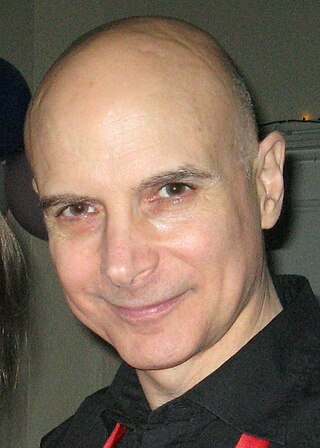
Silvano Levy is an academic specializing in surrealism. He has published on Belgian surrealism with studies on René Magritte, E.L.T. Mesens and Paul Nougé. His research on The Surrealist Group in England began with a film on Conroy Maddox and the book Conroy Maddox: Surreal Enigmas (1995), while a wider interest in the movement led to the editorship of Surrealism: Surrealist Visuality (1997). Levy has curated national touring exhibitions of the work of Maddox and Desmond Morris, and has published a monograph on the latter entitled Desmond Morris: 50 Years of Surrealism (1997), which was followed by the enlarged re-edition Desmond Morris: Naked Surrealism (1999). Subsequent books on Morris include Lines of Thought: The Drawings of Desmond Morris (2008) and three volumes of an analytical catalogue raisonné spanning eight decades. Silvano Levy's monograph on Maddox, The Scandalous Eye. The Surrealism of Conroy Maddox, was published by Liverpool University Press in 2003. The year 2015 saw the publication of Decoding Magritte. Further studies cover Sheila Legge, Dalla Husband, Toni del Renzio, André Breton, Dina Lenković, Jean-Martin Charcot, Mary Wykeham and Birmingham surrealism. Dr Levy is editor of Surrealist Bulletin and has held academic posts at the University of Liverpool, Newcastle Polytechnic, the University of Bath, the University of Hull and Keele University, where he was promoted to Senior Lecturer in French in 1998 and then to Reader in 2005.
Robert Melville was an English art critic and journalist. Along with the artists Conroy Maddox and John Melville, he was a key member of the Birmingham Surrealists in the 1930s and 1940s. An early biographer of Picasso, he later become the art correspondent of the New Statesman and the Architectural Review.
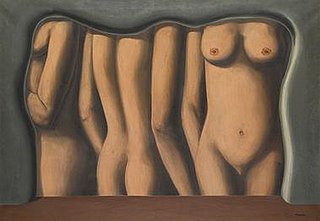
The Adulation of Space is a painting in oil on canvas, 81 × 116 cm, created between 1927–28 by Belgian surrealist artist René Magritte. It is held in a private collection.

Groupe Art et Liberté was an Egyptian artistic and political movement active from 1938 to 1948, about the time of the Second World War. Among the founders was the Surrealist poet Georges Henein; the group was based mostly but not exclusively on Surrealism.
Don Quichotte was a weekly Communist publication which existed between 1939 and 1940 in Cairo, Egypt. The title, which was given by Henri Curiel, a cofounder, was a reference to Gabriel Alomar, a Catalan poet and writer.
Al Tatawwur was an Arabic language literary and cultural magazine published in Egypt in the period January–July 1940. It was the first avant-garde, surrealist and Marxist-libertarian publication in the Arab world.
References
- 1 2 3 4 David Hopkins (2018). "William Blake and British Surrealism: Humphrey Jennings, the Impact of Machines and the Case for Dada". Visual Culture in Britain . 19 (3): 312. doi:10.1080/14714787.2018.1522968. S2CID 192737893.
- 1 2 Steven Connor (1995). "British Surrealist Poetry in the 1930s". In Gary Day; Brian Docherty (eds.). British Poetry, 1900–50. London: Palgrave Macmillan. p. 169. doi:10.1007/978-1-349-24000-5_11. ISBN 978-1-349-24000-5.
- 1 2 3 4 5 6 Jutta Vinzent (2020). "The Making of Modern Art through Commercial Art Galleries in 1930s London: The London Gallery (1936 to 1950)". Visual Culture in Britain. 21 (2): 147, 162, 164. doi:10.1080/14714787.2020.1738265. S2CID 219411278.
- ↑ London Bulletin. Arno Press. 1938.
- 1 2 3 4 Denis-J. Jean (February 1975). "Was There an English Surrealist Group in the Forties? Two Unpublished Letters". Twentieth Century Literature. 21 (1): 81, 87. doi:10.2307/440531. JSTOR 440531.
- ↑ Rod Mengham (2009). "'National Papers Please Reprint': Surrealist Magazines in Britain: Contemporary Poetry and Prose (1936–7), London Bulletin (1938–40), and Arson: An Ardent Review (1942)". In Peter Brooker; Andrew Thacker (eds.). The Oxford Critical and Cultural History of Modernist Magazines. Oxford: Oxford University Press. p. 691. doi:10.1093/acprof:osobl/9780199654291.003.0038. ISBN 9780191803635.
- ↑ P. B. R. (Autumn 1939). "Foreign Periodicals". The Kenyon Review . 1 (4): 473. JSTOR 4332119.
- 1 2 James Gifford (2015). "Late modernism's migrations: San Francisco Renaissance, Egyptian anarchists, and English post-Surrealism". Textual Practice . 29 (6): 1057. doi:10.1080/0950236X.2015.1024725. S2CID 162388367.
- ↑ Sam Bardaouil (2013). ""Dirty Dark Loud and Hysteric": The London and Paris Surrealist Exhibitions of the 1930s and the Exhibition Practices of the Art and Liberty Group in Cairo". Dada/Surrealism. 19 (1): 1–24. doi: 10.17077/0084-9537.1273 .
- ↑ Arthur M. Minters (1967). "A Talk on Modern Art Periodicals". Books at Iowa. 7 (1): 3–8. doi: 10.17077/0006-7474.1297 .
- ↑ Marcel Mariën; Beth Roudebush (1962). "another kind of CINEMA". Film Comment . Vol. 1, no. 3. p. 14. JSTOR 43752656.